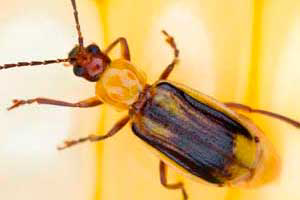Study: Nematodes encapsulated to better tackle corn pests

Nematodes have shown promise as biological control agents in the fight against the western corn rootworm, whose larval stage is a costly pest of corn in the United States and Europe. But current spray methods used to apply the beneficial nematodes can be labour-intensive and water-consuming.
As an alternative, a team of scientists with the U.S. Department of Agriculture (USDA) and the University of Neuchatel (UniNE) in Switzerland is field-testing gel capsule formulations that encapsulate the pest-killing nematode Heterorhabditis bacteriophora. This nematode species poses no danger to humans, pets or livestock, but its lethality to rootworm larvae may give corn growers another option for protecting their crops, together with the use of insecticides and rotations with non-host crops like soybean.
Ivan Hiltpold, a visiting UniNE scholar, is investigating the technology as part of a two-year assignment with Bruce Hibbard, an entomologist with the USDA’s Agricultural Research Service (ARS) Plant Genetics Research Unit in Columbia, Mo. ARS entomologist Wade French and UniNE professor Ted Turling are collaborating with them.
Their approach calls for encapsulating Heterorhabditis within an algal-based polymer that’s soft enough for the nematodes to escape once applied to soils where rootworm larvae are present. After locating their prey, the nematodes wriggle inside the rootworm larvae and release symbiotic bacteria, which multiply and then kill the insect by poisoning its blood. The nematodes feed on the bacteria and mate, spawning new generations that eventually leave their dead hosts to find new ones.
Although the encapsulated nematodes (about 2,700 per capsule) reduced rootworm damage to corn roots better than spray formulations in trials, refinements to the capsules proved necessary, including determining the optimal thickness of capsule walls and storage conditions. During laboratory experiments, for example, twice as many nematodes escaped capsules stored at room temperature (around 77 degrees Fahrenheit) than at 45 degrees F.
The team is also examining the addition of rootworm attractants and feeding stimulants to better lure the pests to their doom.
Source: ARS











